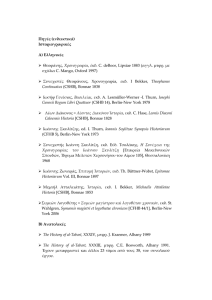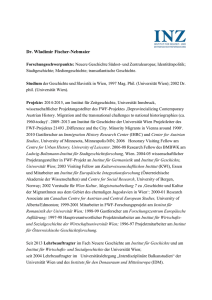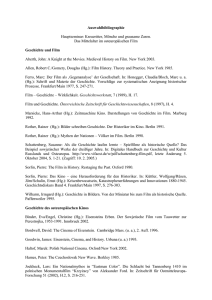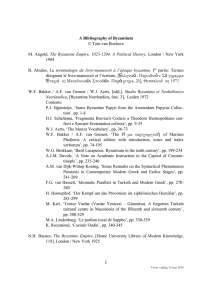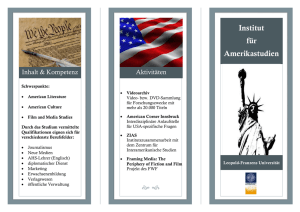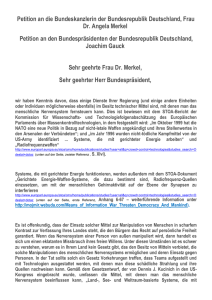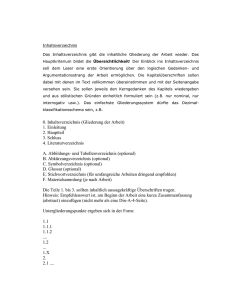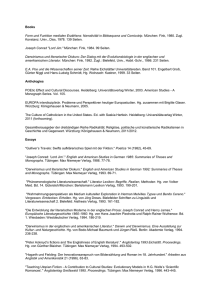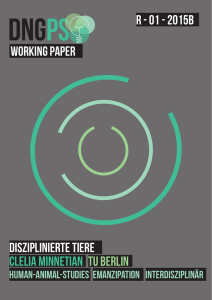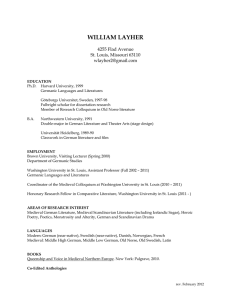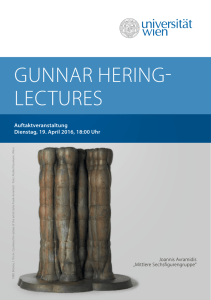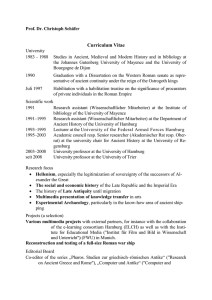Page | Alexander Beihammer Associate Professor Department of
Werbung
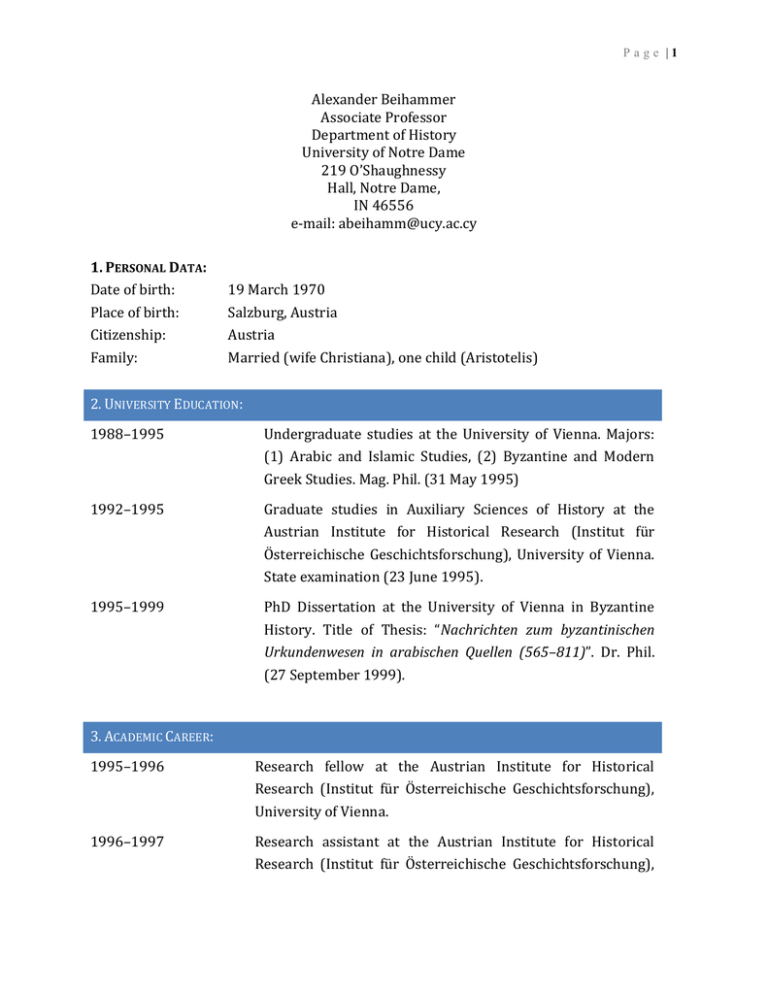
P age |1 Alexander Beihammer Associate Professor Department of History University of Notre Dame 219 O’Shaughnessy Hall, Notre Dame, IN 46556 e-mail: [email protected] 1. PERSONAL DATA: Date of birth: 19 March 1970 Place of birth: Citizenship: Salzburg, Austria Austria Family: Married (wife Christiana), one child (Aristotelis) 2. UNIVERSITY EDUCATION: 1988–1995 Undergraduate studies at the University of Vienna. Majors: (1) Arabic and Islamic Studies, (2) Byzantine and Modern Greek Studies. Mag. Phil. (31 May 1995) 1992–1995 Graduate studies in Auxiliary Sciences of History at the Austrian Institute for Historical Research (Institut für Österreichische Geschichtsforschung), University of Vienna. State examination (23 June 1995). 1995–1999 PhD Dissertation at the University of Vienna in Byzantine History. Title of Thesis: “Nachrichten zum byzantinischen Urkundenwesen in arabischen Quellen (565–811)”. Dr. Phil. (27 September 1999). 3. ACADEMIC CAREER: 1995–1996 Research fellow at the Austrian Institute for Historical Research (Institut für Österreichische Geschichtsforschung), University of Vienna. 1996–1997 Research assistant at the Austrian Institute for Historical Research (Institut für Österreichische Geschichtsforschung), P age |2 University of Vienna. 1 July 1997–31 August 2001 Research assistant at the Center of Byzantine Studies (Kommission für Byzantinistik), Austrian Academy of Sciences, Vienna. September 2001– February 2003 Visiting Lecturer in Byzantine History at the Department of History and Archaeology, University of Cyprus. 1 March 2003–30 June 2008 Assistant Professor in Byzantine History at the Department of History and Archaeology, University of Cyprus. 1 July 2008 to February 2015 Associate Professor in Byzantine History at the Department of History and Archaeology, University of Cyprus. 2008 Primo loco-ranking for the position of a Professor of Byzantine Studies at the University of Vienna: declined (for family reasons). February 2015 to present Professor of Byzantine History at the University of Cyprus (with unpaid leave from 1 September 2015) August 2015 to present Associate Professor of Byzantine History at the University of Notre Dame 4. TEACHING (UNIVERSITY OF CYPRUS) Undergraduate Courses: 1. Introduction into Byzantine History (HIS 112). 2. Byzantium and the Arabs (HIS 291). 3. Diplomacy and Cross-cultural Communication in Byzantium (HIS 213). 4. Society and Economy in the Palaeologan Period (HIS 297). 5. Byzantium in the Period of Iconoclasm (700–867) (HIS 206). 6. Byzantium in the Comnenian Period (HIS 251). 7. Early Byzantium: the Barbarian Migrations (HIS 238). Undergraduate Seminars: 1. The Period of the Conquest of Constantinople (HIS 320). 2. Byzantium and the Fourth Crusade (HIS 321). 3. Byzantium and the Crusades (HIS 323). P age |3 Graduate Seminars: 1. Sources for the History of Cyprus, 645–965 (HIS 635). 2. Reading Documents of Byzantine Diplomatics (HIS 638). 3. Byzantine Diplomatics (HIS 503). 4. Byzantine Sources of the Comnenian Period (HIS 639). 5. Byzantium in the Eighth Century (HIS 640). 6. The Period of the Macedonian Dynasty (HIS 641). 7. Byzantine Cyprus in the Twelfth Century (HIS 643). 8. Byzantium and Islam: The Expansion of the Turks in Asia Minor (HIS 644). 9. Crusades (HIS 533). 10. Byzantium and Islam: Conflict and Exchange. 11. Historiography and Historical Thought (HIS 522). LANGUAGES (in declining order of proficiency): Speaking: German, Greek, English, French Reading: Ancient Greek, Arabic, Latin, Ottoman and Modern Turkish, Persian, Italian 5. COORDINATION OF RESEARCH PROGRAMS 1. A Byzantine-Arab Prosopography for the Period of the Macedonian Dynasty (8671025): two-year internal program funded by the University of Cyprus (2008-2010) and conducted in cooperation with the Center of Byzantine Prosopography (Prosopographie der Mittelbyzantinischen Zeit) of the Academy of Sciences in Berlin (Berlin-Brandenburgische Akademie der Wissenschaften). 2. Byzantine Documentary Sources of the Nicean Empire (1204-1261): two-year program funded by the Leventis Foundation (July 2011-December 2013). 3. Continuity and Change in the Perception of Natural Space, the Land Use and Settlement in Byzantine Eastern Mediterranean (6th-13th Centuries): three-year post-doc program for Dr. Myrto Veikou co-funded by the Hellenic Republic and the European Union and directed by the Department of History and Archaeology at the University of Crete. The Department of History and Archaeology at UCY participates in the program as host institution abroad for the period September 2012-September 2014. P age |4 6. MEMBERSHIP IN EDITORIAL BOARDS Associate editor of Al-Masā q: Islam and the Medieval Mediterranean (Associate Editor), UK, Routledge, Taylor & Francis Group. 7. CONFERENCES ORGANIZED Co-organizer along with Maria Parani and Chris Schabel: Medieval Diplomatics in the Eastern Mediterranean: Aspects of Intercultural Communication, UCY, Department of History and Archaeology, Nicosia, 7-9 April 2006. Co-organizer along with Vassilis Christidis and Theodoros Papadopoullos: Eleventh International Congress on Graeco-Oriental and African Studies, Nicosia, 27-30 September 2007. Co-organizer along with Stavroulla Constantinou and Maria Parani: Court Ceremonies and Rituals of Power in the Medieval Mediterranean, UCY, Department of History and Archaeology, Department of Byzantine and Modern Greek Studies, Nicosia, 26-28 November 2010. 8. LIST OF PUBLICATIONS MONOGRAPHS (SINGLE-AUTHORED) [1] Nachrichten zum byzantinischen Urkundenwesen in arabischen Quellen (565–811), Freie Universität Berlin, Byzantinisch-Neugriechisches Seminar, ΠΟΙΚΙΛΑ ΒΥΖΑΝΤΙΝΑ 17 (Bonn, 2000). lxxxvii + 514 pp. [2] Quellenkritische Untersuchungen zu den ägyptischen Kapitulationsverträgen der Jahre 640–646, Österreichische Akademie der Wissenschaften, phil.-hist. Klasse, Sitzungsberichte 671 (Vienna, 2000). 71 pp. [3] Griechische Briefe und Urkunden aus dem Zypern der Kreuzfahrerzeit. Die Formularsammlung eines königlichen Sekretärs im Vaticanus Palatinus Graecus 367, Zyprisches Forschungszentrum, Quellen und Studien zur Geschichte Zyperns 57 (Nicosia, 2007). 434 pp. MONOGRAPHS (CO-AUTHORED) [4] Regesten der Kaiserurkunden des oströmischen Reiches von 565–1453, bearbeitet von Franz Dölger. 1. Teil, 2. Halbband: Regesten von 867–1025, zweite Auflage neu P age |5 bearbeitet von Andreas Müller, unter verantwortlicher Mitarbeit von Alexander Beihammer (Munich: C. H. Beck Verlag, 2003). 248 pp (my own contribution comprises 292 nos. or 46% of the volume). CO-EDITED VOLUMES [5] A. Beihammer, M. G. Parani, C. D. Schabel, eds., Diplomatics in the Eastern Mediterranean 1000–1500. Aspects of Cross-Cultural Communication, The Medieval Mediterranean 74 (Leiden, Boston: Brill, 2008). [6] A. Beihammer, S. Constantinou, M. Parani, eds., Court Ceremonies and Rituals of Power in Byzantium and the Medieval Mediterranean: Comparative Perspectives, The Medieval Mediterranean 98 (Leiden, Boston: Brill, 2013). [7] G. Christ, F.-J. Morche, R. Zaugg, W. Kaiser, St. Burkhardt, A. Beihammer, eds., Union in Separation: Diasporic Groups and Identities in the Eastern Mediterranean (1100-1800), Researches in Humanities, History (Rome: Viella, 2015). COLLABORATION IN LEXICA [8] Prosopographie der mittelbyzantinischen Zeit. Zweite Abteilung (867-1025), nach Vorarbeiten F. Winkelmanns erstellt von R.-J. Lilie, C. Ludwig, Th. Pratsch, B. Zielke, unter Mitarbeit von H. Bichlmeier, B. Krönung, D. Föller sowie A. Beihammer, G. Prinzing, 8 vols. (Berlin: Walter de Gruyter, 2013). ARTICLES IN BOOKS OR COLLECTIVE VOLUMES [9] “Zypern und die byzantinisch-arabische Seepolitik vom 8. bis zum Beginn des 10. Jahrhunderts,” in Y. Y. al-Hijji and V. Christides, eds., Aspects of Arab Seafaring: An Attempt to Fill in the Gaps of Maritime History (Athens, 2002), pp. 41-62. [10] “‘Der byzantinische Kaiser hat doch noch nie was zustande gebracht’: Diplomatische Bemerkungen zum Briefverkehr zwischen Kaiser Isaak II. Angelos und Sultan Saladin von Ägypten,” in K. Belke, E. Kislinger, A. Külzer, M. A. Stassinopoulou, eds., Byzantina Mediterranea: Festschrift für Johannes Koder zum 65. Geburtstag (Vienna, 2007), pp. 1328. [11] “Eastern Mediterranean Diplomatics: The Present State of Research,” in A. Beihammer, M. G. Parani, C. D. Schabel, eds., Diplomatics in the Eastern Mediterranean 1000-1500: Aspects of Cross-Cultural Communication, The Medieval Mediterranean 74 (Leiden, Boston, 2008), pp. 1-24. P age |6 [12] A. Beihammer, C. Schabel, “Two Small Texts on the Wider Context of the Martyrdom of the Thirteen Monks of Kantara in Cyprus, 1231,” in E. Motos Guirao, M. Morfakidis Filactós, eds., POLYPTYCHON/ΠΟΛΥΠΤΥΧΟΝ: Homenaje a Ioannis Hassiotis (Granada, 2008), pp. 69-82. [13] “Comparative Approaches to the Ritual World of the Medieval Mediterranean,” in A. Beihammer, S. Constantinou, M. Parani, eds., Court Ceremonies and Rituals of Power in Byzantium and the Medieval Mediterranean: Comparative Perspectives, The Medieval Mediterranean 98 (Leiden, Boston, 2013), pp. 1-33. [14] “Comnenian Imperial Succession and the Ritual World of Niketas Choniates’ Chronike Diegesis,” in A. Beihammer, S. Constantinou, M. Parani, eds., Court Ceremonies and Rituals of Power in Byzantium and the Medieval Mediterranean: Comparative Perspectives, The Medieval Mediterranean 98 (Leiden, Boston, 2013), pp. 159-202. ARTICLES IN JOURNALS [15] “Die alpenländische Annalengruppe (AGS) und ihre Quellen,” Mitteilungen des Instituts für Österreichische Geschichtsforschung 106 (1998), pp. 253-327. [16] “‘Reiner christlicher König’ – πιστὸς ἐν Χριστῷ τῷ Θεῷ βασιλεύς: Eine Studie zur Transformation kanzleimäßigen Schriftguts in narrativen Texten am Beispiel kaiserlicher Auslandsbriefe des 10. Jahrhunderts an muslimische Destinatäre,” Byzantinische Zeitschrift 95 (2002), pp. 1-34. [17] “Der harte Sturz des Bardas Skleros: Eine Fallstudie zu zwischenstaatlicher Kommunikation und Konfliktführung in der byzantinisch-arabischen Diplomatie des 10. Jahrhunderts,” Römische Historische Mitteilungen 45 (2003), pp. 21-57. [18] “‘Audiatur et altera pars’: η βυζαντινο-αραβική συγκυριαρχία στην Κύπρο υπό το πρίσμα των αραβικών πηγών,” Κυπριακαί Σπουδαί 64-65 (2000-2001) [published 2003], pp. 157-176. [19] “The First Naval Campaigns of the Arabs against Cyprus (649, 653): A Reexamination of the Oriental Source Material,” Graeco-Arabica 9-10 (2004) [= Festschrift in Honor of V. Christides], pp. 47-68. [20] “Die Kraft der Zeichen: Symbolische Kommunikation in der byzantinisch-arabischen Diplomatie des 10. und 11. Jahrhunderts,” Jahrbuch der Österreichischen Byzantinistik 54 (2004), pp. 159-189. [21] “Gruppenidentität und Selbstwahrnehmung im zyprischen Griechentum der frühen Frankenzeit. Ein Interpretationsversuch anhand von zeitgenössischen Briefen und Urkunden,” Jahrbuch der Österreichischen Byzantinistik 56 (2006), pp. 205-237. P age |7 [22] “Feindbilder und Konfliktwahrnehmung in den Quellen zum Auftreten der Seldschuken in Kleinasien (ca. 1050-1118),” Byzantion 79 (2009), pp. 48-98. [23] “Die Ethnogenese der seldschukischen Türken im Urteil christlicher Geschichtsschreiber des 11. und 12. Jahrhunderts,” Byzantinische Zeitschrift 102 (2009), pp. 589-614. [24] “Orthodoxy and Religious Antagonism in Byzantine Perceptions of the Seljuk Turks (Eleventh-Twelfth Century),” al-Masāq: Islam and the Medieval Mediterranean 23 (2011), pp. 15-36. [25] “Defection across the Border of Islam and Christianity: Apostasy and Cross-Cultural Interaction in Byzantine-Seljuk Relations,” Speculum 86 (2011), pp. 597-651. [26] “Multilingual Literacy at the Lusignan Court: The Cypriot Royal Chancery and its Byzantine Heritage,” Byzantine and Modern Greek Studies 35 (2011), pp. 149-169. [27] “Muslim Rulers Visiting the Imperial City: Building Alliances and Personal Networks between Constantinople and the Eastern Borderlands (Fourth/Tenth-Fifth/Eleventh Century),” al-Masāq: Islam and the Medieval Mediterranean 24 (2012), pp. 157-177. [28] “Die römische Kirche und das Papsttum des Reformzeitalters in der Wahrnehmung muslimisch-arabischer Quellen,” Mitteilungen des Instituts für Österreichische Geschichtsforschung 121 (2013), pp. 267-297. [29] “The Kingdom of Cyprus and Muslim-Christian Diplomacy in the Age of Meḥ med the Conqueror,” Crusades 12 (2013), pp. 197-232. ARTICLES IN CONFERENCE PROCEEDINGS [30] “Byzantine Chancery Traditions in Frankish Cyprus: the Case of the Vaticanus MS Palatinus Graecus 367,” in S. Fourrier and G. Grivaud, eds., Identités croisées en un milieu méditerranéen: le cas de Chypre (Antiquité – Moyen Âge) (Rouen, 2006), pp. 301315. [31] “Byzantinische Diplomatik: (Dead or Alive?),” in E. Jeffreys, ed., Proceedings of the 21st International Congress of Byzantine Studies, London 21-26 August 2006, vol. 1: Plenary Papers (Aldershot, 2006), pp. 173-187. [32] “Der Vierte Kreuzzug und die Eroberung Konstantinopels im Spiegel orientalischer Quellen,” in P. Piatti, ed., The Fourth Crusade Revisited: Atti della Conferenza Internazionale nell’ ottavo centenario della IV Crociata 1204-2004, Andros, 27-30 maggio 2004, Atti e Documenti 25 (Vatican, 2008), pp. 244-274. [33] “Byzanz und die islamische Staatenwelt im Zeitalter Kaiser Basileios’ II. und des Kalifen al-Ḥā kim”, in Thomas Pratsch, ed., Konflikt und Bewältigung: Die Zerstörung der P age |8 Grabeskirche zu Jerusalem im Jahre 1009, Millenium Studies 32 (Berlin, Boston: Walter de Gruyter, 2011), pp. 173-193. [34] “‘Der König der Deutschen – Gott verfluche ihn – brach auf mit einer gewaltigen Streitmacht’ – Die Wahrnehmung abendländischer Herrscher in den arabischen Quellen zum Dritten Kreuzzug”, in K.-H. Ruess, ed., Stauferzeit – Zeit der Kreuzzüge, Schriften zur staufischen Geschichte und Kunst 29 (Göppingen: Gesellschaft für Staufische Geschichte, 2011), pp. 86-123. [35] “Strategies of Identification and Distinction in the Byzantine Discourse on the Seljuk Turks,” in W. Pohl, C. Gantner, R. Payne, eds., Visions of Community in the Post-Roman World: The West, Byzantium and the Islamic World, 300-1100 (Aldershot: Ashgate, 2012), pp. 499-512. [36] “Transkulturelle Kommunikation und Identitätsbildung in den diplomatischen Beziehungen zwischen Byzanz und der islamischen Welt,” in M. Borgolte, J. Dücker, M. Müllerburg, P. Predatsch, B. Schneidmüller, eds., Europa im Geflecht der Welt: Mittelalterliche Migrationen in globalen Bezügen, Europa im Mittelalter 20 (Berlin: Akademie Verlag, 2012), pp. 173-192. [37] “Byzantine Diplomatics,” Report presented at the round table Instrumenta Studiorum of the 22nd International Congress of Byzantine Studies, Sofia, 22-27 August, 2011: www.propylaeum.de/en/byzantine-studies/thematic-portals/instrumentastudiorum/articles, pp. 1-9. [38] “Strategies of Diplomacy and Ambassadors in Byzantine-Muslim Relations of the Tenth and Eleventh Centuries,” in N. Drocourt and A. Becker, eds., Ambassadeurs et ambassades au Coeur des relations diplomatiques. Rome – Occident Médiéval – Byzance (VIIIe s. avant J.-C. - XIIe après J.-C.), Centre de recherche universitaire Lorrain d’histoire, Université de Lorraine 47 (Metz, 2012), pp. 371-400. [39] “Politische Praxis, Ideologie und Herrschaftsbildung in der Frühphase der türkischen Expansion in Kleinasien,” Deutsche Arbeitsgemeinschaft zur Förderung Byzantinischer Studien, Sonderheft (München 2013). [40] Christian Views of Islam in Early Seljuq Anatolia: Perceptions and Reactions, in A. C. S. Peacock, Bruno de Nicola, and Sara Nur Yıldız, eds., Islam and Christianity in Medieval Anatolia (Ashgate: Aldershot, 2015), pp. 51-76 [41] “Lordship and Hegemonial Identity in the Byzantine-Frankish Discourse on the Formation of the Kingdom of Cyprus,” in G. Christ, F.-J. Morche, R. Zaugg, W. Kaiser, St. Burkhardt, A. Beihammer, eds., Union in Separation: Diasporic Groups and Identities in the Eastern Mediterranean (1100-1800), Researches in Humanities, History (Rome: Viella, 2015). P age |9 ARTICLES ACCEPTED FOR PUBLICATION/IN PRESS [42] “The Formation of Muslim Principalities and Conversion to Islam during the Early Seljuk Expansion in Asia Minor,” in Ph. Gelez, G. Grivaud, A. Popovic, eds., Les conversions à l’Islam en Asie Mineure et dans les Balkans aux époques seldjoukide et ottoman, actes de colloque international 26-27 avril 2012, Publications de l’École française d’Athénes, ca. 30 pages. [43] “Letters and Diplomatics,” in A. Riehle, ed., Companion to Byzantine Epistolography, Leiden: Brill 2015, ca. 20 pages. [44] “The Kingdom of Cyprus in the First Ottoman-Venetian War: Aspects of its Military and Political Significance,” in M. Grünbart and S. Rogge, eds., Cyprus in Medieval Times: A Place of Cultural Encounter, Schriften des Instituts für interdisziplinäre Zypernstudien (Münster: Waxmann Verlag), 29 pages. [45] “Changing Strategies and Ideological Concepts in Byzantine-Arab Relations in the Eleventh and Twelfth Centuries,” in J. Pahlitzsch, V. Tsamakda, with the collaboration of K. S. Parker, eds., Monks, Merchants and Artists in the Eastern Mediterranean: The Relations of Byzantium to the Arab Near East (9th to 15th c.), Byzanz zwischen Orient und Okzident. Veröffentlichungen des WissenschaftsCampus Mainz, 35 pages. BOOK REVIEWS AND LEMMATA [46] Irfan Shahîd, Byzantium and the Arabs in the Sixth Century (Washington, 1995), in Jahrbuch der Österreichischen Byzantinistik 51 (2001), pp. 419–426. [47] Prosopographie der mittelbyzantinischen Zeit. Erste Abteilung (641–867), erstellt von R.-J. Lilie, C. Ludwig, Th. Pratsch, I. Rochow, B. Zielke, vol. 1–3 (Berlin, 1999–2000), in Jahrbuch der Österreichischen Byzantinistik 51 (2001), pp. 430–433. [48] ΠΟΙΚΙΛΑ ΒΥΖΑΝΤΙΝΑ 18 (Varia VII), Beiträge von Paul Speck sowie zwei Nachträge von Albrecht Berger und Otto Kresten (Bonn 2000), in Jahrbuch der Österreichischen Byzantinistik 53 (2003), pp. 261–265. [49] Prosopographie der mittelbyzantinischen Zeit. Erste Abteilung (641–867), erstellt von R.-J. Lilie, C. Ludwig, Th. Pratsch, I. Rochow, B. Zielke, vol. 4–6 (Berlin, 2001), in Jahrbuch der Österreichischen Byzantinistik 55 (2005), pp. 259–263. [50] Irfan Shahîd, Byzantium and the Arabs in the Sixth Century, vol. 2, part 1: Toponymy, Monuments, Historical Geography, and Frontier Studies (Washington, D.C., 2002), in Jahrbuch der Österreichischen Byzantinistik 55 (2005), pp. 264–267. [51] Paul Speck, Kaiser Leon III., Die Geschichtswerke des Nikephoros und des Theophanes und der Liber Pontificalis. Teil 1: Die Anfänge der Regierung Kaiser Leons III, ΠΟΙΚΙΛΑ P a g e | 10 ΒΥΖΑΝΤΙΝΑ 19 (Bonn, 2002). Teil 2: Eine neue Erkenntnis Kaiser Leons III. Teil 3: Die Ἀπόστασις Ῥώμης καὶ Ἰταλίας und der Liber Pontificalis. ΠΟΙΚΙΛΑ ΒΥΖΑΝΤΙΝΑ 20 (Bonn, 2003), in Jahrbuch der Österreichischen Byzantinistik 57 (2007) 388–395. [52] Michel Balard, Les Latins en Orient (XIe-XVe siècle) (Paris, 2006), in Mediterranean Historical Review (2008), pp. 186-188. [53] Maria Leontsini, Constantine IV (668–685): The Last Emperor of the Early Byzantine Period. In Greek, National Hellenic Research Foundation, Institute of Byzantine Research, Monographs 7 (Athens, 2006), in Speculum 85 (2010), pp. 988-990. [54] Art. “Leo Choirosphactes,” in: D. Thomas (ed.), Christian-Muslim Relations: A Bibliographical History, vol. 1.2 (Brill, 2010), pp. 117-120. [55] Wolfram Drews, Die Karolinger und die Abbasiden von Bagdad. Legitimationsstrategien frühmittelalterlicher Herrscherdynastien im transkulturellen Vergleich, Europa im Mittelalter, Abhandlungen und Beiträge zur historischen Komparatistik 12 (Berlin: Akademie Verlag, 2009), in Mitteilungen des Instituts für Österreichische Geschichtsforschung 121 (2013), pp. 468-471. [56] Michael Borgolte, Bernd Schneidmüller, eds., Hybride Kulturen im mittelalterlichen Europa. Vorträge und Workshops einer internationalen Frühlingsschule, Europa im Mittelalter, Abhandlungen und Beiträge zur historischen Komparatistik 16 (Berlin: Akademie Verlag, 2010), in Mitteilungen des Instituts für Österreichische Geschichtsforschung 121 (2013), pp. 486-488. [57] Andrew C. S. Peacock and Sara Nur Yıldız, eds., The Seljuks of Anatolia: Court and Society in the Medieval Middle East (London and New York: I.B. Tauris, 2013), in Bulletin of the School of Oriental and African Studies 76 (2013). [58] Angeliki LAIOU (†) – Cécile MORRISSON, eds., Le Monde Byzantin, vol. 3: L’Empire grec et ses voisins XIIIe-XVe siècle, Nouvelle Clio, l’histoire et ses problèmes (Paris: Presses Universitaires des France, 2011), in Jahrbuch der Österreichischen Byzantinistik 63 (2013). [59] Julian Chrysostomides, Byzantium and Venice, 1204-1453, ed. Michael Heslop – Charalambos Dendrinos, Variorum Collected Studies Series CS972 (Farnharm: Ashgate Publishing Company 2011), in Jahrbuch der Österreichischen Byzantinistik 63 (2013). 9. SCHOLARLY PAPERS GIVEN [1] “Μερικές νέες παρατηρήσεις στις πρώτες θαλάσσιες επιδρομές των Αράβων κατά της Κύπρου,” Eighth International Conference of Graeco-Oriental and African Studies, P a g e | 11 Oinousses-Chios, 5-9 July 2000: Shipping and Trade in the Mediterranean from the 7th until the 19th century. [2] “Zur Typologie kaiserlicher Auslandsbriefe an muslimische Destinatäre in der Zeit der makedonischen Dynastie,” 20th International Congress of Byzantine Studies, Collège de France, Sorbonne, 19-25 August 2001. [3] “Η νομική θέση της Κύπρου υπό το πρίσμα Αράβων νομομαθών του 8ου αιώνα,” Ninth International Conference of Graeco-Oriental and African Studies, Neapoli, Laconia, 2630 June 2002: The Ports of the Mediterranean. [4] “Η πτώση του Βάρδα Σκληρού: η διπλωματία ως μέσο διεξαγωγής και τερματισμού διακρατικών συγκρούσεων,” 4η Συνάντηση Βυζαντινολόγων Ελλάδας και Κύπρου, Aristoteles University, Thessalonica, 20-22 September 2002: Byzantium and its Neighbours. [5] “Byzantine Chancery Tradition in Early Frankish Cyprus: The Case of the Vatican MS Palat. Gr. 367,” Colloque international « Identités croisées dans un milieu méditerranéen. Le cas de Chypre », Université de Rouen, 11-13 March 2004. [6] “Der Vierte Kreuzzug und die Eroberung Konstantinopels im Spiegel orientalischer Quellen,” International Conference on the Fourth Crusade (1204): The Fourth Crusade Revisited (Εθνικό Ίδρυμα Ερευνών, Institut für Byzantinistik und Neogräzistik der Universität Wien), Andros, 27-30 May 2004. [7] “Der Vierte Kreuzzug und die Eroberung Konstantinopels im Spiegel orientalischer Quellen,” Lecture Series on the Fourth Crusade, Universität zu Köln, 28 June 2004. [8] “Identität, Eigen- und Fremdwahrnehmung im zyprischen Griechentum der frühen Frankenzeit,” Byzantinisch-Neugriechisches Seminar, FU Berlin, und Prosopographie der Mittelbyzantinischen Zeit, Berlin-Brandenburgische Akademie der Wissenschaften, 8 December 2004. [9] “Greek Identity and Self-image in Early Frankish Cyprus,” The Society for the Study of the Crusades and the Latin East, Symposium at the Centre for Medieval Studies, University of Sydney, July 1, 2005: From the West to the Holy Land in the Age of the Crusades. [10] “The Phenomenon of Defection in Byzantine-Seljuk Relations during the Twelfth and Thirteenth centuries,” CISH Syndney 2005, University of New South Wales, 4 July 2005, The Society for the Study of the Crusades and the Latin East: Peoples and Cultures of the Levant in the Age of the Crusades. [11] “The Power of Signs: Some Remarks on Symbolism in Byzantine-Arab Diplomacy,” Tenth International Congress on Graeco-Oriental and African Studies, Kryoneri Attica, P a g e | 12 25-28 August 2005: East and West: Antagonism and Coexistence from Medieval Times until Today. [12] “Η αυτομολία στο Βυζάντιο: λιποθυμία, καιροσκοπία ή εσχάτη προδοσία;” Specimina Byzantina: Internationales Symposium zu Ehren Prof. R. Reinsch, Nicosia, October 2005. [13] “‘The Byzantine Emperor Has Never Succeeded in Anything’: Remarks on the Letter Exchange between Isaac II and Saladin,” Medieval Diplomatics in the Eastern Mediterranean: Aspects of Intercultural Communication, Nicosia, 7-9 April 2006. [14] “Byzantinische Diplomatik – Dead or Alive?” 21st International Congress of Byzantine Studies, London, 21-26 August 2006. [15] “The Kingdom of Cyprus as Meeting Point of Byzantine and Latin Chancery Traditions,” Political Culture in the Central Middle Ages, c. 950-c. 1250, Bergen, Norway, 18-20 June 2007. [16] “The Origin of the Seljuk Turks as Reflected in Byzantine and Eastern Christian Historiographical Texts from the Eleventh and Twelfth Centuries,” Eleventh International Congress on Graeco-Oriental and African Studies, Nicosia, 27-30 September 2007. [17] “Multilingual Literacy at the Lusignan Court: The Cypriot Royal Chancery and its Byzantine Heritage,” Promotion lecture, Archaeological Research Unit, University of Cyprus, 3 February 2008. [18] “Mehrsprachige Schriftlichkeit im östlichen Mittelmeer. Die Kanzlei des Königreichs Zypern und ihr byzantinisches Erbe,” Public lecture, University of Vienna, 30 May 2008. [19] “Dispute Settlement in a Mixed Society: Some Remarks on the Interaction of Byzantine and Latin Legal Concepts in Frankish Cyprus,” Workshop on Custom and Law, King’s College, London, 9 June 2008. [20] “Inner and Intersphere Contacts: Introduction,” Political Culture in Three Spheres (Byzantium, Islam and the West), Aberystwyth, Wales, 1-3 July 2008. [21] “The Syrians,” Medieval Famagusta, Workshop in Memory of A.H.S. “Peter” Megaw, Nicosia, 25-26 October 2008. [22] “Die Römische Kirche und das Papsttum in der Wahrnehmung muslimisch-arabischer Quellen,” Workshop zum Thema „Die Zentralisierungsphase der lateinischen Kirche im Blick der Nachbarn“ im Rahmen des 3. Arbeitstreffens des DFG-Netzwerks „Zentrum und Peripherie“, Mainz, 6 November 2008. [23] “Der König der Deutschen – Gott verfluche ihn – zog aus mit einer gewaltigen Streitmacht: Kreuzfahrende Kaiser und Könige der Stauferzeit im Spiegel islamischer P a g e | 13 Quellen,” 23. Göppinger Staufertage: Stauferzeit – Zeit der Kreuzzüge, Göppingen, 7-9 November 2008. [24] “Lordship and Hegemonial Identity in the Byzantine-Frankish Discourse on the Formation of the Kingdom of Cyprus,” “Between Parallel Society and Integration: Diasporas and Transcultural Agency in the Eastern Mediterranean in the Late Middle Ages and the Early Modern Era,” Heidelberg, Center of Transcultural Studies at the University of Heidelberg, 7-9 May 2009. [25] “Strategies of Identification and Distinction in the Byzantine Discourse on the Seljuk Turks,” Visions of Community: Ethnicity, Religion and Power in the Early Medieval West, Byzantium and the Islamic World,” Institut für Mittelalterforschung – Wittgensteinprojekt, Austrian Academy of Sciences, Vienna, Austria, 17-20 June 2009. [26] “Orthodoxy and Religious Otherness in the Byzantine Discourse on the Seljuks during the 11th and 12th Centuries,” Political Culture in the Latin West, Byzantine, and Islamic Spheres: Righteous Peoples and Errant Outsiders, International Medieval Congress, Leeds, UK, 13-16 July 2009. [27] “Byzanz und die islamische Staatenwelt,” Konfliktbewältigung vor 1000 Jahren: Die Zerstörung der Grabeskirche in Jerusalem im Jahre 1009, Internationale Tagung des Akademievorhabens Prosopographie der mittelbyzantinischen Zeit, BerlinBrandenburgische Akademie der Wissenschaften, 24-25 September 2009. [28] “Μεσαιωνική Κύπρος και γερμανικός διαφωτισμός: το ιστορικό σύγγραμμα του καθηγητή Johann Paul Reinhard, 1766-1768,” Όψεις της Κλειώς: Ιστοριογραφία της Κύπρου, Ημερίδα προς τιμήν του καθηγητή Ιωάννη Χασιώτη, Department of History and Archaeology, Nicosia, 15 June 2010. [29] “Muslim Rulers Visiting the Imperial City,” Political Culture in the Latin West, Byzantine, and Islamic Spheres: Travelling Rulers, International Medieval Congress, Leeds, UK, 13-16 July, 2010. [30] “Strategies of Diplomacy and Ambassadors in Eleventh-Century Byzantine-Muslim Relations,” Aux origins d’une diplomatie méditerranéenne: les ambassadeurs, moyens humains de la diplomatie, Colloque international, Centre Régional Universitaire Lorrain d’Histoire, Centre de Recherches en Histoire Internationale et Atlantique, Metz, France, 14-16 October 2010. [31] “Comnenian Imperial Succession and the Ritual World of Niketas Choniates’ Chronike Diegesis,” Court Ceremonies and Rituals of Power in the Medieval Mediterranean, Department of History and Archaeology, Department of Byzantine and Modern Greek Studies, Nicosia, 26-28 November 2010. [32] “Transkulturelle Kommunikation und Identitätsbildung in den diplomatischen Beziehungen zwischen Byzanz und der islamischen Welt (vornehmlich 10.-12. Jh.),” P a g e | 14 Das europäische Mittelalter im Geflecht der Welt. Integrative und desintegrative Effekte von Migrationen. Schwerpunktprogramm 1173: Integration und Desintegration der Kulturen im europäischen Mittelalter, Berlin 25-28 May 2011. [33] “Diplomatik,” 22nd International Congress of Byzantine Studies, Sofia, 22-27 August 2011, Round Table Session: Instrumenta Studiorum (Albrecht Berger, Claudia Sode). [34] “The Kingdom of Cyprus and Muslim-Christian Diplomacy in the Age of Mehmed the Conqueror.” 22nd International Congress of Byzantine Studies, Sofia, 22-27 August 2011, Round Table Session: Cyprus between East and West (Svetlana Bliznyuk, Tassos Papacostas). [35] “Komnenian Imperial Rituals and their Narrative Representation in Byzantine Historiographical Texts,” 22nd International Congress of Byzantine Studies, Sofia, 2227 August 2011, Round Table Session: Political Cultures in Constantinople, the Provinces and Beyond (Catherine Holmes, Rosemary Morris, Jonathan Shepard) [36] “Islam and its Relations with Byzantium,” Workshop: Byzantium in Transition 2011, Nicosia, Archaeological Research Unit, 28-30 October 2011 (Athanasios Vionis). [37] “Conversion to Islam in the Time of the Early Seljuk Expansion in Asia Minor,” Les conversions à l’Islam en Asie Mineure et dans les Balkans aux époques seldjoukide et ottomane, Athens, École française d’Athènes, 26-28 April 2012 (Philippe Gelez, Gilles Grivaud, Alexandre Popovic). [38] “Seljuk Intrusion, Assimilation and Political Culture in eleventh-century Syria and Asia Minor,” Workshop: Cross-Cultural Life-Worlds in Pre-Modern Islamic Societies: Actors, Evidences and Strategies, Universität Bamberg, Zentrum für Interreligiöse Studien, 2224 June 2012 (Birgit Hoffmann, Şevket Küçükhüseyin). [39] “Süleyman-shā h, the Son of Kutalmish: Rebellion and State Founding in EleventhCentury Anatolia,” International Medieval Congress 2012, Session: Rebellion, Resistance, and Subversion in Byzantium, the Latin West, and the Medieval Islamic World. Leeds, UK, 9-12 July, 2012 (Jonathan Shepard, Catherine Holmes, Jo van Steenbergen, Björn Weiler). [40] “Ideological Trends and Developments in Byzantine-Arab Diplomatic Relations from the Eleventh to the Thirteenth Centuries,” Monks, Merchants and Artists in the Eastern Mediterranean. The Relations of Byzantium to the Arab Near East (9th to 15th c.). Johannes Gutenberg Universität Mainz, Institut für Europäische Geschichte, 17-19 Octover 2012 (Johannes Pahlitzsch, Vasiliki Tsamakda). [41] “The Role of the Kingdom of Cyprus in the First Ottoman-Venetian War (1463-1479).” Cyprus in Medieval Times: Place of Cultural Encounter, Westfälische WilhelmsUniversität Münster (Institut für Byzantinistik und Neogräzistik, Institut für P a g e | 15 Interdisziplinäre Zypern-Studien), 6-8 December 2012 (Michael Grünbart, Sabine Rogge). [42] “Politische Praxis, Ideologie und Herrschaftsbildung in der Frühphase der türkischen Expansion in Kleinasien,” Festvortrag auf der Arbeitstagung der Deutschen Arbeitsgemeinschaft zur Förderung Byzantinischer Studien, Köln, 31. Januar-2. Februar 2013 (Fritz-Thyssen-Stiftung, Apostelnkloster 13-15) (Albrecht Berger, Claudia Sode). [43] “Christian Views of Islam in Early Seljuk Anatolia: Perceptions and Reactions,” International Workshop: The Reception of Islam in Anatolia and its Neighbours, Koç University Research Center for Anatolian Civilizations, Istanbul, 6-7 September 2013 (European Research Council Starting Grant 284076 “The Islamisation of Anatolia, c. 1100-1500”, Andrew Peacock).
